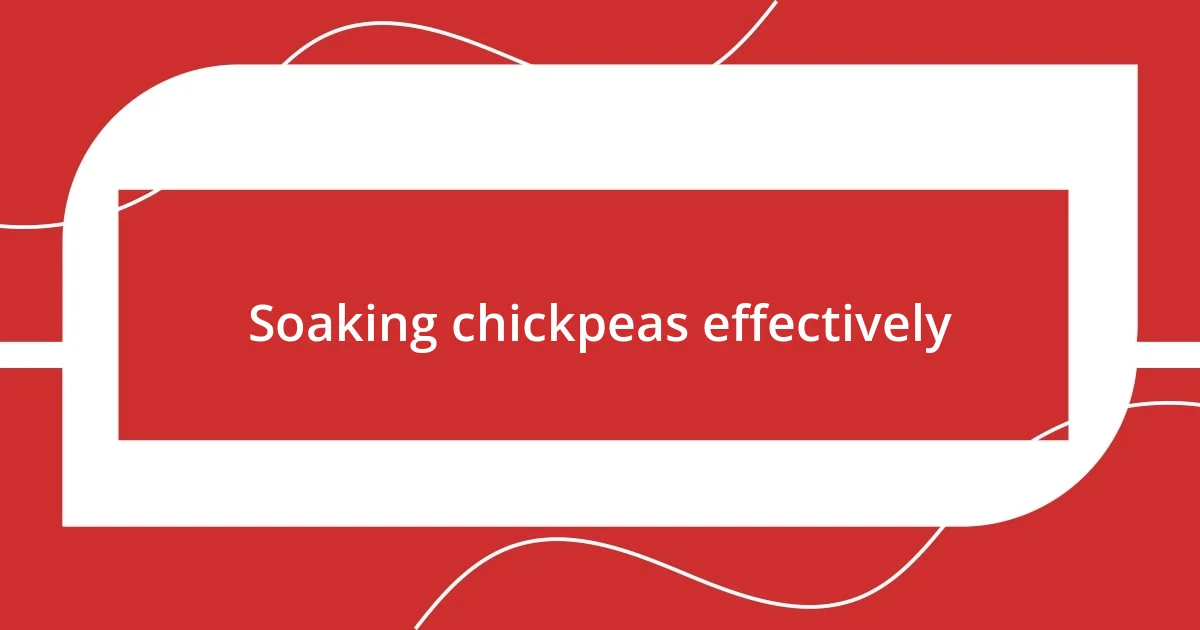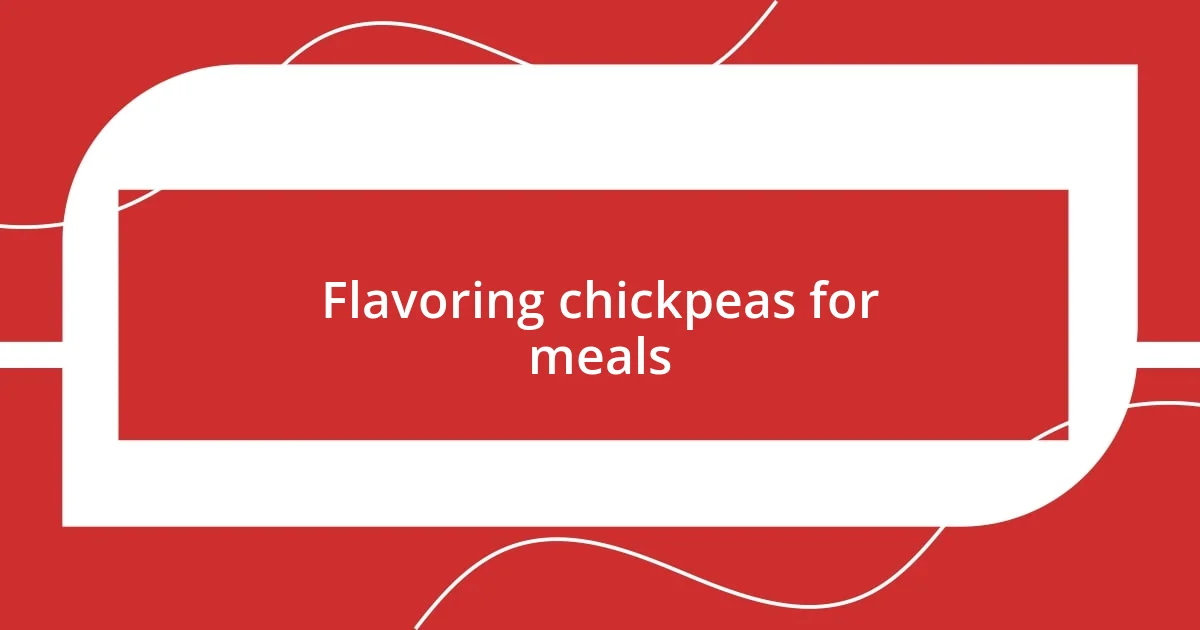Key takeaways:
- Soaking chickpeas properly enhances their texture and flavor; overnight soaking is preferred for optimal results.
- Experimenting with different cooking methods, like stovetop and pressure cooking, can yield delicious, versatile dishes such as curries, salads, and hummus.
- Flavoring chickpeas early in the cooking process and avoiding common mistakes (like insufficient soaking and liquid ratio) significantly improves the final dish.

Introduction to chickpeas cooking
Chickpeas have a special place in my kitchen; they’re my go-to ingredient when I want to whip up something nutritious and satisfying. The first time I cooked them, I was amazed at how versatile they could be. Have you ever noticed how chickpeas can transform from simple legumes into creamy hummus or a hearty stew? It’s almost magical.
What I love most about cooking chickpeas is their ability to absorb flavors. When I first experimented with spices, my kitchen filled with enticing aromas that had my family gathering around the stove, eager for a taste. It made me realize that cooking, especially with ingredients like chickpeas, is more than just following a recipe—it’s about exploration and connection.
I can still recall that moment when I served my first chickpea curry to friends. The smiles on their faces were priceless, and in that instant, I understood how food can bridge gaps and create memories. Chickpeas aren’t just a meal for me; they’re a canvas for creativity, inviting me to explore flavors, textures, and cultures with every dish I prepare.

Choosing the right chickpeas
When it comes to choosing chickpeas, I’ve learned that the type you select can truly elevate your dish. I often find myself reaching for dried chickpeas over the canned variety. While canned chickpeas are convenient, nothing compares to the flavor and texture of dried ones that you soak and cook yourself. There’s a certain satisfaction in watching them transform as they absorb water, expanding into little gems of goodness.
- Dry or Canned: Choose dried for better flavor and custom texture. Canned is great for quick meals.
- Appearance: Look for uniform size and a lovely beige color. Avoid any that look shriveled or discolored.
- Freshness: If possible, source from local markets or bulk bins. Fresh chickpeas have a lovely, earthy scent.
- Varieties: Explore the different types, like the small, nutty-flavored “Desi” or the larger “Kabuli.” Each brings unique flavors to your dishes.
I still remember the first time I experimented with different varieties at a local farmers’ market. I stumbled upon a vendor with vibrant purple chickpeas, and I knew I had to try them. The excitement of cooking with something new invigorated my kitchen experiments, reminding me that making food choices can be a true adventure.

Soaking chickpeas effectively
Soaking chickpeas is a crucial step that I’ve come to appreciate over time. I’ve learned that it’s not just about wetting them and calling it a day; the soaking process is essential for achieving that perfect texture. I often soak them overnight, letting the chickpeas swell and soften, which ultimately reduces cooking time and enhances their creaminess. There’s something comforting about waking up to a bowl of chickpeas that have perfectly absorbed the water, an invitation to get creative in the kitchen.
I’ve also discovered that the longer you soak, the better the flavor can develop. Some people swear by the quick soak method—boiling them for a minute and then letting them sit for an hour. While that approach can work, I find that patience truly pays off. One memorable cooking session involved soaking chickpeas for over 12 hours. The resulting dish, a vibrant chickpea salad, was so flavorful and tender that it became a staple in my meal prep routine. Have you ever felt the satisfaction of preparing a dish that tastes significantly better than expected? It’s in those moments that the effort feels worth it.
Interestingly, I’ve also come to realize that soaking chickpeas in salt water not only enhances their flavor but also aids in digestion. After reading about it, I decided to give it a try during one of my cooking experiments. The softened chickpeas were delightful, and my stomach thanked me later. Soaking effectively is indeed an art—one that I continually refine with each batch, embracing the learning journey it brings along the way.
| Soaking Method | Description |
|---|---|
| Overnight Soak | Soak chickpeas in water for 8-12 hours; best for texture and flavor. |
| Quick Soak | Boil for 1 minute, then let sit for 1 hour; faster but less flavorful. |
| Salt Water Soak | Soak in salted water; enhances flavor and aids digestion. |

Cooking methods for chickpeas
When it comes to cooking chickpeas, there are several methods that I’ve dabbled with over the years. My personal favorite is the classic stovetop method, where I simmer soaked chickpeas for about an hour. I remember the first time I did this—I was amazed as the kitchen filled with a warm, nutty aroma that made my mouth water. It felt like I was on a culinary journey, standing over the pot and watching those humble legumes transform into tender morsels.
Pressure cooking is another technique I’ve found indispensable, especially when I’m short on time. I often turn to my trusty pressure cooker, which can cut the cooking down to just 15 minutes without losing that creamy texture I love. The excitement builds as I release the steam and lift the lid to reveal perfectly cooked chickpeas, reminding me of how efficient cooking can be. Have you ever had that eureka moment in the kitchen, where a gadget just changes everything? That’s exactly how I felt.
Roasting chickpeas has also become a delightful method in my culinary repertoire. Tossing cooked chickpeas in spices and olive oil before baking them creates a crispy snack that satisfies my cravings. I’ll never forget the first time I experimented with different spice blends; the flavors were a revelation, and my friends couldn’t get enough. Have you ever tried something that completely changed your view on a dish? Roasted chickpeas became an unexpected party favorite, showing me how versatile these little legumes can be.

Flavoring chickpeas for meals
Flavoring chickpeas opens up a world of delicious possibilities. I love experimenting with various spices and herbs to elevate the flavor. One of my go-to blends is a combination of cumin, paprika, and garlic powder. I vividly remember the first time I tossed my chickpeas in this mix before roasting; the aroma filled my kitchen and brought my family running for a taste. Isn’t it remarkable how a few simple ingredients can transform a dish into something unforgettable?
I’ve also become quite fond of using fresh herbs straight from my little kitchen garden. One summer, I had an abundance of rosemary, and I decided to infuse my chickpeas with it. The result was a fragrant, herbaceous delight that brought a rustic twist to my salads. It truly was a game-changer; every bite was like a taste of sunshine. Have you ever discovered a flavor combination that surprised you? I relish those moments of culinary magic.
Another technique I’ve embraced is marinating chickpeas. A few hours in a mixture of olive oil, lemon juice, and seasonings can do wonders. I recall a warm autumn evening when I prepared marinated chickpeas for a gathering. The tangy, zesty flavor made them a hit, and I felt a sense of pride in sharing something so simple yet so satisfying. It’s in these flavorful experiments that I’ve found joy in cooking chickpeas—they’re a canvas for creativity!

Recipes using cooked chickpeas
When it comes to recipes using cooked chickpeas, one of my absolute favorites is a hearty chickpea salad. I love combining cooked chickpeas with diced cucumbers, tomatoes, and a sprinkle of feta cheese. The first time I tossed in a handful of fresh parsley, the colors were so vibrant that it felt like summer on a plate. Don’t you find that the simplest ingredients can create the most pleasing dishes?
Another dish I’ve enjoyed creating is chickpea curry. The way chickpeas soak up spices like cumin and turmeric is nothing short of magical. I remember the warmth of the spices enveloping my kitchen one chilly evening, transforming it into a cozy refuge. It’s wild how a single pot of curry can warm not just the body, but also the soul; have you ever had a meal that wrapped you in comfort like a soft blanket?
And let’s not forget about making hummus! Blending cooked chickpeas with tahini, lemon juice, and garlic always feels like a celebration in my kitchen. I have vivid memories of preparing it for a friend’s gathering; the smooth, creamy texture and rich flavor left everyone coming back for more. It’s fascinating how something so simple can serve as a canvas for creativity, right? Hummus has become my go-to appetizer, proving that good food often springs from effortless inspiration.

Common mistakes when cooking chickpeas
One common mistake I see often is not soaking dried chickpeas long enough or, even worse, skipping the soaking altogether. I once thought I could skip this step in a rush, but the resulting texture was less than desirable—think grainy and tough instead of the creamy, tender bite I craved. If you want perfectly cooked chickpeas, give them a proper soak overnight; your future self will thank you.
A frequent blunder is cooking chickpeas without adjusting the water ratio. When I first tackled chickpea stews, I under-estimated the amount of liquid needed, resulting in a dry dish that felt incomplete. Now, I make it a point to monitor the liquid levels closely, knowing that chickpeas are thirsty little legumes that can absorb plenty of flavors if given the right environment. Have you ever noticed how a well-balanced dish is usually a happy one?
Lastly, I’ve learned that seasoning chickpeas only at the end of cooking can lead to missed opportunities for flavor. I still remember the first time I sautéed chickpeas with spices right from the start—it was an eye-opening experience that unlocked a depth of flavor I hadn’t anticipated. The aroma wafting through my kitchen told me I was onto something special, and it’s a step I now never skip. What’s your favorite way to flavor chickpeas? Experimenting at different stages really can make all the difference!















